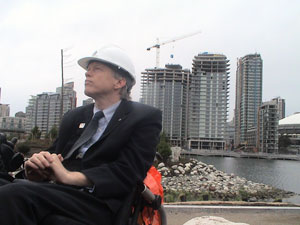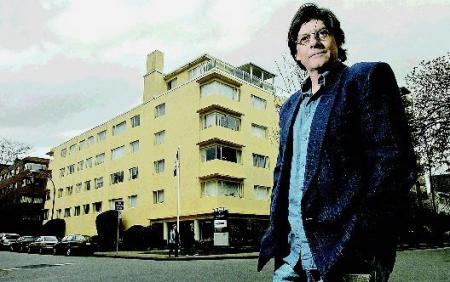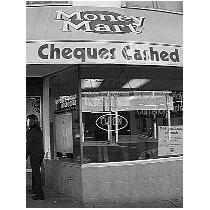Anxiety grows over EcoDensity in Vancouver
Charlie Smith
Other

Vancouver mayor Sam Sullivan isn’t shy about touting the benefits of higher densities, which sets him apart from most nicipal politicians in the region.
A major difference between municipalities and higher orders of government is the level of public participation before decisions are made. In Parliament or in the B.C. legislature, bills routinely become laws without public input. At the municipal level, there is sometimes a legal requirement to hold public hearings.
At times, elected officials will listen quietly to public input and do what they intended all along. On other occasions, hordes of speakers will descend on a council chamber and force politicians to take notice if they want to keep their jobs after the next election.
It happened 12 years ago when more than 1,000 speakers showed up at Chilliwack city council and forced then-mayor John Les to abandon a proposal to create a new community of 40,000 people on agricultural land at Ryder Lake. Public pressure also stopped another major development on the Spetifore agricultural lands in Tsawwassen in 1989 after the longest public hearing in Canadian municipal history.
The City of Vancouver has been going through a similar exercise—and hearing considerable public angst—over EcoDensity, which is a plan to enhance sustainability with more concentrated, ecologically friendly development. Scores of speakers showed up in the council chamber for a public hearing that lasted over seven evenings. On Tuesday (April 15), Vancouver city council will vote on a staff recommendation to instruct the director of planning, “in response to public input”, to revise the draft EcoDensity Charter and 16 proposed “initial actions”.
<>Mayor Sam Sullivan launched the EcoDensity Initiative in June 2006, suggesting that it could help improve environmental sustainability, enhance housing affordability, and improve livability. “Many people who are upset about building decisions, zoning decisions, blame EcoDensity for any new developments,” Sullivan told the Georgia Straight in an April 8 phone interview. “In fact, we’ve gone two years since I announced this process, and not one bylaw has been changed. So we have the most extensive public-consultation process that I’ve seen in my 15 years on council.”
Brent Toderian, the city’s planning director, says EcoDensity will help residents cope with rising energy costs and the growing impact of climate change. “Right off the bat, higher density reduces your energy signature: the amount of energy you use and the amount of greenhouse gases you generate on a per-unit basis,” Toderian told the Straight in an interview after the public hearing concluded on April 3. “Smaller units with shared walls—right off the bat—emit less greenhouse gases per unit and per square foot. The density also creates a critical mass of economics that allows you to do greener technology, district energy systems, et cetera.”
Toderian said that the “vast majority of our carbon footprint” results from buildings and transportation. “The density, of course, makes the other modes of transportation work much better—the sustainable modes—starting with walking, biking, transit, et cetera,” he said. “Density is necessary to make those more sustainable modes of transportation viable.”
The draft EcoDensity Charter calls for environmental sustainability to become “a primary consideration in decisions about density, design, and land use”. It also calls for “a range of housing types, needs, and costs”. The three-page draft charter emphasizes improving environmental performance and sustainability, suggesting that this is “critical for Vancouver’s long term resiliency and is the foundation for future social, cultural, and economic sustainability”.
“The need for deeper and more rapid change has become clear as our achievements are being challenged by accelerating environmental threats,” the draft charter states.
The draft actions include such things as: requiring LEED (Leadership in Energy and Environmental Design) Silver equivalency rating in rezonings for buildings larger than 600 square metres; providing incentives, such as excluding space for “green” mechanical equipment from a developer’s floor-space ratio; allowing site-specific rezonings in low-density areas for EcoDensity demonstration projects, including on city land; and providing more options for secondary suites, new options for laneway infill housing, and new options for mid-rise housing on arterial streets.
The Straight presents the following report about the final night of the public hearing, on April 3, to provide some insights into why EcoDensity has aroused such passions. On this evening, the speakers included developers, a former city planner and development consultant, neighbourhood and heritage advocates, a construction manager, and political activists, as well as ordinary citizens.
The first two speakers were Robert Brown and Heather Tremain, partners in reSource Rethinking Building Inc., a green development firm that included a car cooperative at the Verdant, a 60-unit townhouse development on Burnaby Mountain. Brown, who said he shops in his Main Street neighbourhood and uses transit, said that he strongly believes density and livability are “very easy bedfellows”.
He cited a project at 11th Avenue and Yukon Street, just two houses away from Vancouver City Hall, where his company built four units on a 50-foot lot. It added 25 percent more density than would exist in a single-family neighbourhood. He then mentioned a six-unit townhouse project that his company developed in Strathcona that provided 50 percent more density than a single-family neighbourhood. His own home is in a multi-unit complex at 27th Avenue and Quebec Street that has 100 percent more density than nearby single-family areas.
Brown suggested in his own understated way that the rhetoric around densification had gotten a little bit out of hand. “It’s interesting that we move from discussions around coach-house infill to eight-storey high-rises right next to single-family [homes],” Brown noted wryly. “I don’t think that’s what the EcoDensity Charter is about.”
Tremain said that some of the draft actions, such as requiring LEED Silver designation through rezonings, are quite readily achievable. “These things won’t be a stretch for folks,” Tremain said. “It will be kind of a base-line requirement.”
She urged council to pay attention to affordability, emphasizing that this can be achieved through creative zoning. She cited one example on the West Side in which the city gave additional density for a 10-unit project. She noted that this enabled four of the units to be sold at below-market prices. “So you have some precedent here already,” she said.
COPE councillor David Cadman then asked Tremain if there should be energy-rating systems for buildings similar to the energy-rating systems for appliances. Tremain replied that it’s very costly and complicated to reduce energy costs in green buildings. “The rest of the pieces are fairly easy to achieve,” she noted.
Next up was blunt-speaking heritage advocate Anthony Norfolk, chair of the Gastown Historic Area Planning Committee. He told council that his committee supports the draft EcoDensity Charter but opposes two draft actions proposed by council that are “targeted at Gastown”. One is to set up a panel to advise on furthering the goals of EcoDensity; the other is to develop a program that will provide a citywide context for determining where and how to make land-use changes “beyond existing plans and policies, in order to further improve sustainability, affordability, and livability”.
“Now it seems someone wants to blow the lid off Gastown again,” Norfolk said, referring to previous efforts to develop a soccer stadium and build a freeway through the historic district.
Norfolk was followed by East Vancouver resident John Colenutt. He claimed that he was a “victim” of EcoDensity two years ago—even though EcoDensity hadn’t been proposed at that point—when his annual property taxes increased by $1,000. The land in his neighbourhood near Kingsway and Knight was rezoned. He cited this rezoning as the cause of a 50-percent tax hike.
“The shock hit me a couple of years ago,” he told council. “I sort of saw the writing on the wall.”
A few minutes later, in the lobby outside the council chamber, Colenutt told the Straight that he thinks EcoDensity will cause homeowners’ taxes to increase across the city after their land is rezoned and B.C. Assessment slaps on higher values. “What I see is a massive tax grab disguised as EcoDensity,” Colenutt declared. “It has already happened to me. I’m one of the first people locked into this new zoning.”
The speaker after Colenutt, Katherine Reichert of the Shaughnessy Heights Property Owners Association, told council that her group opposes the draft EcoDensity Charter because it would override existing policies. She specifically mentioned the First Shaughnessy Official Development Plan, Shaughnessy Design Guidelines, and the neighbourhood’s single-family zoning, “which currently serves Shaughnessy, its residents, and the city with great success”.
“The EcoDensity Charter has the potential to change the historical character of Shaughnessy and ruin its streetscape,” she said.
Reichert also claimed that the charter is “not transparent”, and then she said a few words on her own behalf, not speaking for the association. “The city needs to ask itself why the EcoDensity Charter has created a fear—and a letter opposing the charter signed by 25 neighbourhood groups,” she said. “The charter should be written to alleviate fears and have the neighbourhood communities work together to create EcoDensity initiatives.”
The next speaker, Harvey Des Roches, ramped up the criticism of EcoDensity. He described the CityPlan Community Visions process as a democratic exercise and wondered why EcoDensity was being pushed through the initial stage so quickly. “Is it because it’s an election year?” he asked. “Is it because of the lobbying power and campaign funding provided by…developers?”
He was followed by Elizabeth Murphy, a former city employee in the housing and properties department and a board member of Heritage Vancouver. “Last year, I won a City of Vancouver heritage award for a project I completed in Point Grey, which includes a restored heritage house with secondary suite and infill,” she said. “However, I oppose the density charter and initial actions because they use density as the number one tool to reduce our ecological footprint—with density having priority over affordability and livability.”
Murphy delivered a detailed criticism of EcoDensity, emphasizing that the city should simply rely on its existing Community Climate Change Action Plan and the CityPlan Community Visions process. The city’s climate-change plan calls for reducing greenhouse-gas emissions in residential buildings and supporting the principles of smart growth, including increasing density around rapid-transit stations.
She argued that the “density charter” and the proposed initial actions are skewed toward new construction and the demolition of existing structures. “The greenest building is one that is already built,” Murphy noted. “What is the point of recycling our pop bottles if we throw out our largest consumer item, our buildings? Retaining and reusing existing buildings is recycling at a grand scale.”
Murphy went on to say that there is already greater zoning capacity than is necessary to house the number of residents expected to live in Vancouver by 2021. She noted that the Community Visions process was undertaken to identify more housing types and would likely add more capacity in the future. She pointed out that there are 18,000 vacant suites in the city and thousands of homeless people. “It shows we are building the wrong product for the wrong demographics,” she said.
The next two speakers were quite concise. Robert Angus said he was neither for nor against EcoDensity. He claimed that he just wanted to warn council to make sure that the federal and provincial governments are onside to ensure there will be adequate public services, including hospitals and judges, to cope with a larger population. In one of the shortest presentations ever before council, Angela Woo took only one sentence to state that she doesn’t believe the draft EcoDensity Charter represents the wishes of a majority of Vancouver residents.
After Woo, COPE’s Ellen Woods-worth delivered a much longer address. She focused a lot of attention on homelessness and claimed that there is no “eco” in EcoDensity. Woodsworth also maintained that EcoDensity is a plan to enrich developers and put more density into poor neighbourhoods, leading to more evictions and more homelessness.
She was followed by former COPE council candidate Mel Lehan, who spoke on behalf of Neighbourhoods for a Sustainable Vancouver. Lehan brought up the mayor’s roundtable meeting with 20 Dunbar residents last February. “Mayor Sullivan said about EcoDensity: ‘If neighbourhoods don’t want to be involved in this, it’s not going to happen,’ ” Lehan said. “The neighbourhoods want to make it clear that we do not support the EcoDensity Initiative.”
He read from a letter submitted to council by more than two dozen neighbourhood groups that urged the city to withdraw the draft EcoDensity Charter and proposed initial actions. Lehan was followed by development consultant Jim Lehto, who questioned whether or not the city has the authority in the Vancouver Charter to link zoning to improved environmental performance. Lehto, a former city planner, suggested that desirable environmental objectives should be made mandatory in the city’s building bylaw rather than be left to the zoning process.
“The negative side of EcoDensity is the elevation of so-called green technology to a righteous moral plateau at the expense of meat-and-potato issues affecting the city, such as affordable, nonmarket rental housing, homelessness, health care, employment, and expeditious rezoning and permit-processing,” Lehto said.
After the meeting ended, NPA councillor Suzanne Anton told the Straight that she thinks there has been sufficient debate on the actions and that it may be time to vote on them. “Each action item itself requires more process,” she noted. “If the lane-oriented housing is one we move forward on, we’re not going to start building lane-oriented housing the next day. It has to go out again [for public discussion] to figure out where it should be built.”
Anton claimed that it would take another decade and a half to implement new housing forms through the Neighbourhood Centres Program, and the EcoDensity Charter is necessary to accelerate the process. She added that she is “totally convinced” that many more people will migrate to Vancouver because of environmental problems elsewhere, including in “those dry American cities”.
“That will drive our prices really high,” she predicted, noting that the only way to address this is to ensure there are new supplies of housing.
COPE’s Cadman told the Straight that Sullivan has always supported higher densities, and he put the eco prefix in front of it to make this concept more friendly to residents. When asked about Anton’s comments, Cadman replied, “I would love to believe that Councillor Anton is thinking about the future of the city. I think she is thinking more specifically about her donation base.”
Sullivan later told the Straight this was “a cynical comment” by Cadman. “It is not easy politically to support density,” Sullivan insisted. “There is no mayor on the continent that I know of that is willing to put their name with the word density. So no one who knows municipal politics would ever believe that a mayor would endorse higher densities for political reasons. It’s ludicrous.”






